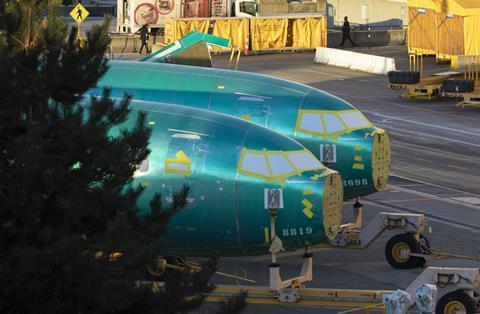Boeing lost $355 million during a first quarter marred by a high-profile safety scare and the subsequent slowdown of its narrowbody aircraft production rates.
However, that figure still represents an improvement for the Arlington, Virginia-headquartered firm. In the equivalent period last year, Boeing posted a $425 million loss.
Disclosing its first-quarter performance on 24 April, Boeing said it generated $16.6 billion of revenue during the first three months of the year, down 8% from last year’s $17.9 billion figure.
“Our first-quarter results reflect the immediate actions we’ve taken to slow down 737 production to drive improvements in quality,” says chief executive Dave Calhoun.
“We will take the time necessary to strengthen our quality and safety management systems and this work will position us for a stronger and more stable future.”

The results were a mixed picture for Boeing as it works to recover from the 5 January in-flight failure of an Alaska Airlines 737 Max 9’s mid-cabin door-plug – an event investigators suggest resulted from the airframer’s failure to install door bolts.
Boeing has since provided Alaska with $160 million in compensation for the event and subsequent grounding of most of the global fleet of Max 9s.
The accident has proven to be a seismic event for Boeing and the airline industry as a whole. The Federal Aviation Administration (FAA) capped 737 production at 38 aircraft per month – though it is reportedly producing far fewer narrowbody jets than that – and the company enacted the management overhaul critics have long called for, including the planned departure of Calhoun at year-end.
Calhoun insists that the company is righting the ship and setting itself up for long-term success.
“We are already beginning to see signs of more predictable and reduced cycle times in our factory as a result of these enhanced quality control standards,” he says.
With aircraft deliveries down to 83, compared with 130 in the first quarter of 2023, revenue generated by Boeing Commercial Airplanes dropped 31%, to $4.7 billion from $6.7 billion a year earlier.
”During the quarter, the 737 program slowed production below 38 per month to incorporate improvements to its quality management system and reduce travelled work within its factory and supply chain,” the company says.
“In addition, [Boeing] Commercial Airplanes is implementing a comprehensive action plan to address feedback from the FAA audit of 737 production.”
Boeing received 125 commercial aircraft orders during the period, including 85 Max 10s for American Airlines and 28 777Xs for various customers, with Ethiopian Airlines ordering eight of the type. Both the Max 10 and 777X have yet to be certificated by the FAA.
In the defence sector, Boeing Defense, Space and Security was profitable during the period, reporting a profit of $151 million on revenues of $7 billion. Its operating margin increased more than 2%, “primarily driven by higher volume and improved performance”.
In other positive news, Boeing is making progress on clearing its inventory of 737s and 787s. As of 31 March, Boeing had about 110 737 Max 8s that were built prior to 2023 still waiting delivery, primarily to airline customers in China and India. That was about 30 fewer aircraft than at the end of 2023.
”By the end of this year,” Calhoun says, ”we expect to have largely delivered our 737 and 787 inventory, effectively shutting down our two large shadow factories.”































